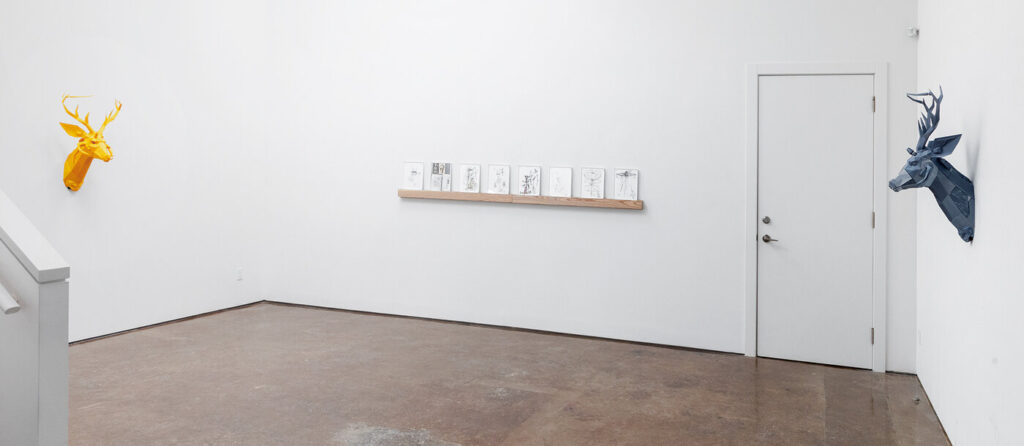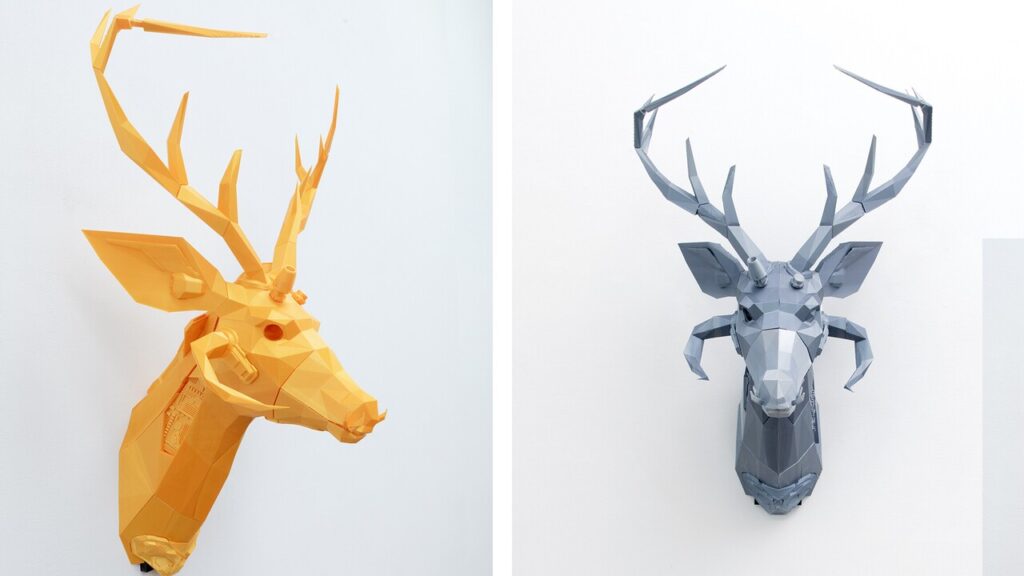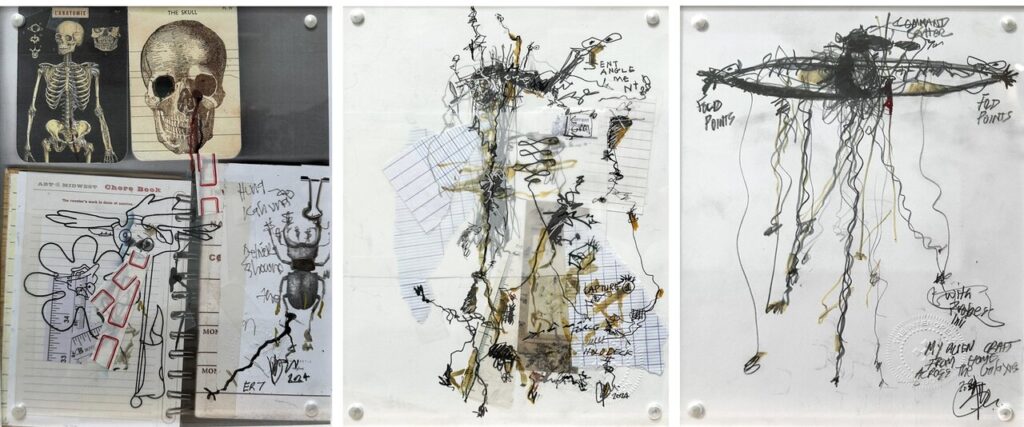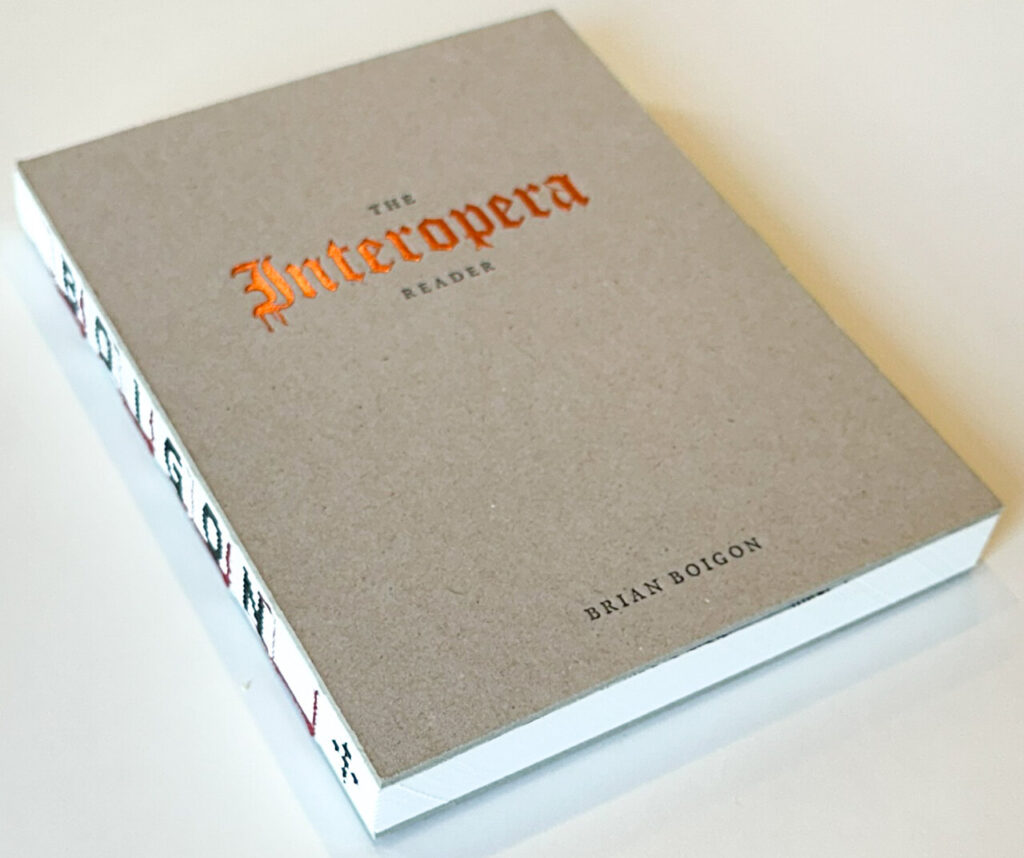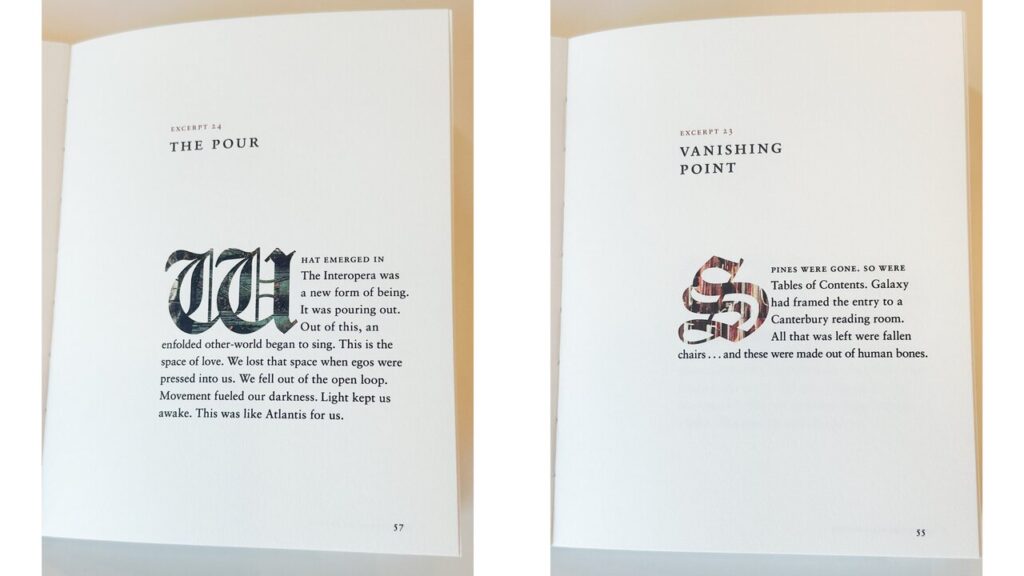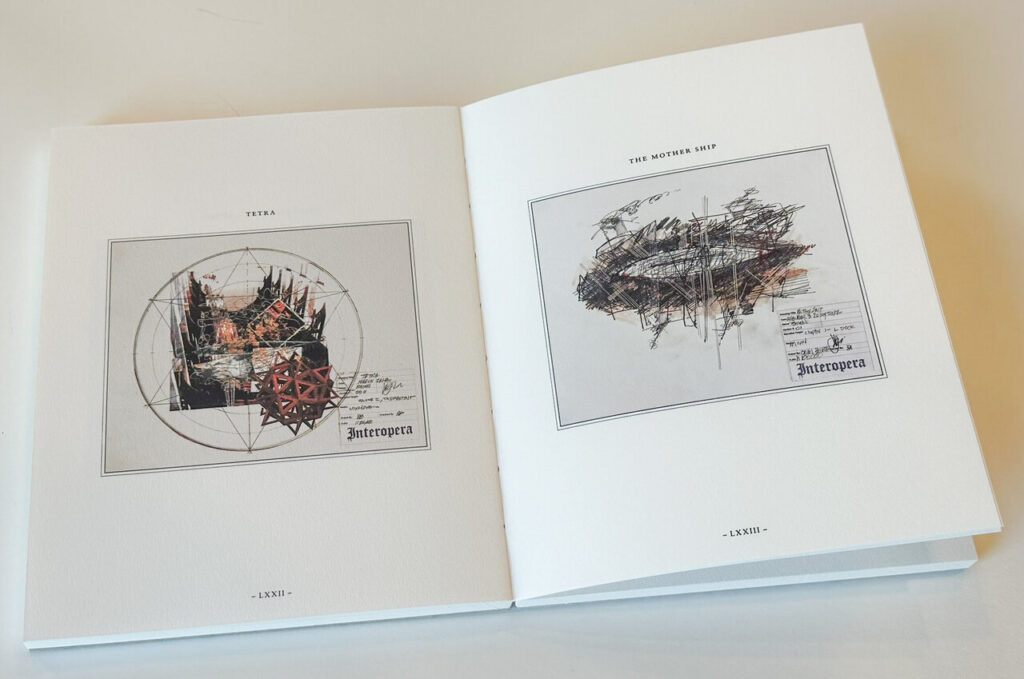At first glance, Brian Boigon’s work can be quite puzzling. It will require a deep dive into interconnected ideas before you can make sense of the individual pieces. So, get ready to play detective or archaeologist as you try to piece things together. But don’t worry, the effort will pay off. As you work to decipher what’s on display, you’ll discover a universe full of ideas. In Boigon’s exhibition “ER1 2 3 4” at Christie Contemporary, you’ll encounter fragmented documentation and a mix of artifacts hinting at a larger, elusive narrative.
Installation view of ER1 2 3 4 at Christie Contemporary
Two stag heads, one orange and one grey, face off across an austere white room. Mounted like hunting trophies, they are 3D printed in a faceted, low-poly style indicative of an artificial or simulated reality. They appear to have technical enhancements such as extra horns, parts that look like data connectors, as well as exposed mechanics or controls.
Stag I (left) and Stag II (right), both 3D printed sculpture
On the wall between these figures, is a series of works on paper displayed in acrylic blocks. These are frenetically sketched pen and ink drawings with some collaged elements and a few words of text. They are rendered in intertwisted, flowing lines drawn with a pen that rarely seems to lift from the paper.
Installation view (above) & (L-R) ER2, ER3, ER8 each collage and ink on paper
To provide context, it’s important to understand that this exhibition, as well as Boigon’s other recent projects, are conceptually situated within a unifying fiction he refers to as the Interopera, a sprawling science fiction saga involving aliens, quantum entanglement, folding space-time and other esoteric concepts.
You could take the name Interopera to be an amalgam of a ‘space opera’, an elaborate science fiction narrative, and the word ‘interoperable’, which describes something that can work with many disparate systems. Interopera suggests a narrative structure that transgresses conventional boundaries between disciplines.
The Interopera Reader
Seeking clarity, you might reach for the Interopera Reader – a book on display and for sale at the gallery. It’s a beautiful, tactile piece, an artwork in itself, with a unique binding and cover. The book contains a set of text ‘excerpts’ and a folio of drawings. Each short text begins with an elaborate illuminated gothic letter. Through the colourful interior of each drop-cap figure you can glimpse a small part of a drawing. The constricted view, a mere glimpse of a larger diagram, is analogous to the fragment of narrative that the excerpts provide. In your role as an archeologist, you’ll have to fit the pieces together and fill in what’s missing.
Excerpt Pages from the Interopera
Returning to the work now that you have a bit more context, you surmise that the heads on the wall are characters in the Interopera narrative. They’re a kind of hybrid life form caught in a state of entanglement, “everything and nothing at the same time.”
The drawings now take on new meaning as sketches of the events, creatures, and machines of the Interopera. Perhaps they are the snarled records produced by a firsthand witness. Are these knotted, dense entanglements of ink and hastily written words attempts at describing things beyond our current comprehension? Or are they the plans and design documents of alien minds?
Boigon’s work draws heavily on the strange world of quantum mechanics. As scientific discoveries continue to unfold, the true nature of the universe is revealed to be more bizarre, and further from what our intuition tells us. The environment our human senses perceive is only a rough approximation of our surroundings. Our intuitive model of reality has served us well in our evolutionary past, but we must accept that it is incomplete and contingent. From a human perspective, the true nature of the universe contradicts our senses. It’s not in our nature to understand this stuff. As the physicist Richard Feynman puts it “If you think you understand quantum mechanics, you don’t understand quantum mechanics.”
Folio pages from the Interopera Reader
The arts have often been influenced by the fields of science and philosophy. Think of psychology and surrealism, relativity and cubism, deconstruction and deconstructivist architecture. The conceptual cross-over does not necessarily involve a rigorous adherence to scientific sources but rather acts as a conceptual framework for new creative endeavors. Boigon embraces current science and extrapolates forward to a distant imagined future. He also reaches back to stories of the mythological past. He mashes these ideas up to develop his unique universe which in turn informs his particular creations.
For those of us with creative ambitions, there are two significant lessons here. Firstly, there’s immense value in venturing beyond one’s disciplinary boundaries for inspiration. The fusion of ideas from diverse fields often yields greater creative potential than remaining within the historical precedents of familiar territory. Secondly, there’s the value of embracing mystery. Delving into Boigon’s crafted universe and grappling with its enigmatic aspects will spark the viewer’s own imagination, providing fertile ground for creative exploration. As a viewer, you’re invited to collaboratively construct an imagined realm in tandem with the artworks on display.
Boigon’s work does not readily resolve to a didactic message. It remains mysterious and may well leave you with a sense of intellectual vertigo. You, acting as the archeologist, don’t have all the pieces. You have fragments and excerpts and are left to interpolate your own meaning. You’ll have to work at it – but there’s fun and freedom in that. In the Interopera, the effort, your effort to make sense of it, is the message.
Mikael Sandblom
Images are courtesy of Christie Contemporary.
*Exhibition information: Brian Boigon, ER1 2 3 4, January 20 – February 17, 2024, Christie Contemporary, 64 Miller Street, Toronto. Gallery hours: Wednesday – Saturday 11 – 5 pm.

